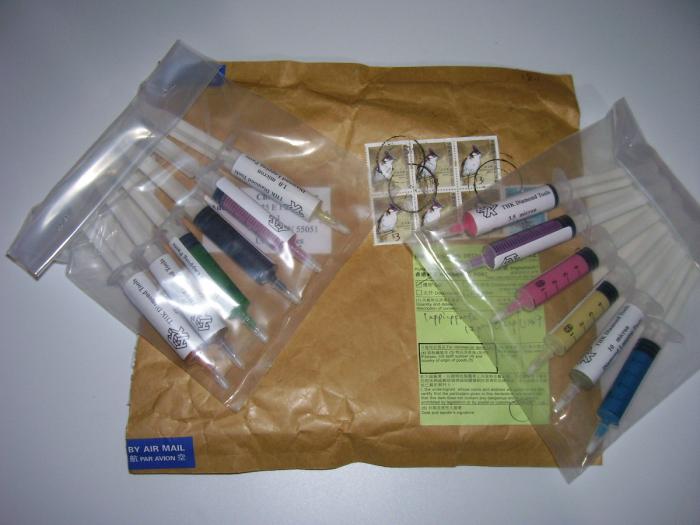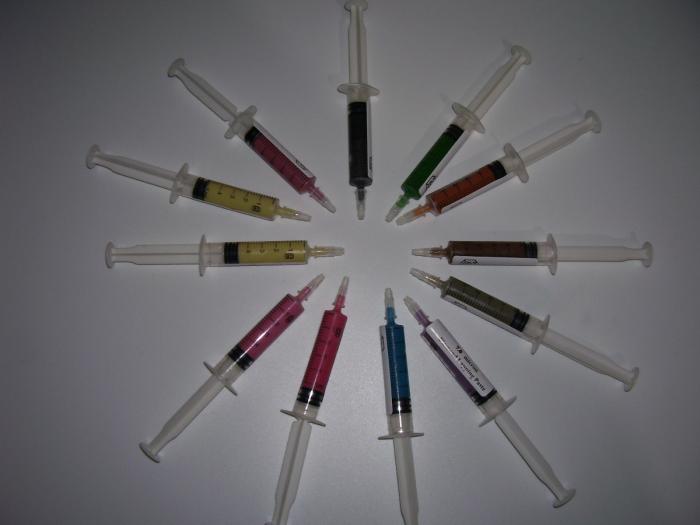Results 1 to 10 of 23
-
08-22-2009, 08:21 AM #1
 12 different particle size diamond pastes!
12 different particle size diamond pastes!
I came across this link on Coupe Chou Club: THK DIAMOND TOOLS
Members there are happy with communication and quality.
Just wanted to share. I am not that much into pastes so can't tell you if they are any good.Plus ça change, plus c'est la même chose. Jean-Baptiste Alphonse Karr.
-
08-22-2009, 09:08 AM #2

Damn. I only want one of them...but $30 shipped is really cheap. Too cheap, to be honest...
-
08-22-2009, 09:53 AM #3

Jim, I'll buy them all and sell the one you want to you for a tenner
 Plus ça change, plus c'est la même chose. Jean-Baptiste Alphonse Karr.
Plus ça change, plus c'est la même chose. Jean-Baptiste Alphonse Karr.
-
08-23-2009, 03:38 AM #4

Thanks Kees. I'll be the guinea pig. I ordered them. Although I really have not liked the consistency of the DMT oil based pastes I have in 1, 3 & 5 micron, if this is legit, I'm on my way to try stropping with pastes from start to finish. The DMT oil based pastes are in a thick grease base and do not spread easily. I should try disolving them in some alcohol or something, maybe that would help.
I would assume all 12 of these pastes would be monocrystaline. Ideally I would like to try mono grits to let's say 8k to 10k range and then finish with polycrystaline diamond. My unsupported and untested (validity = zero, I know)theory is that high grit diamond pastes feel "harsh" to most people because they're mono instead of poly. The poly is not as "shard" like and cuts smoother.
Thanks again, Kees!
Chris L"Blues fallin' down like hail." Robert Johnson
"Aw, Pretty Boy, can't you show me nuthin but surrender?" Patti Smith
-
08-23-2009, 06:33 AM #5

Hi Chris,
Interesting experiment. I wouldn't use alcohol but rather petroleum-based solvent (similia similibus solvuntur). Alcholol is both water and petroleum soluble. IME it does not mix as well with every oily substance.
Please let us know the results.
I have a Dutch barbers' manual from 1910 that says that French razors were sharpened using only pasted wood and a leather strop. According to its authors any wood without knots can be used. I presume the bevel was set by the manufacturer.Plus ça change, plus c'est la même chose. Jean-Baptiste Alphonse Karr.
-
The Following User Says Thank You to Kees For This Useful Post:
ChrisL (08-26-2009)
-
10-05-2009, 02:12 AM #6
 NEWS?
NEWS?
Hey Chris, have you ever tried these yet?
I'm interested, and figure several others might be also...
-
10-05-2009, 03:30 AM #7

If they're really great, please don't everyone order them all at once and cause the price to double.

-
10-05-2009, 04:22 AM #8
 UPDATE ON DIAMOND PASTES
UPDATE ON DIAMOND PASTES
Yes, I received the 12 pastes. It took less than two weeks from the day I ordered until the day I received which, from Hong Kong to the USA is fine with me. They were packaged well.


All the colors of the rainbow or something like that; each paste, thankfully is colored differently. Of course, when applied to a substrate, the color disappears and they all look the same.
The reason I have not posted sooner on any progress with this is because:
- Although I'm not the most scientific or meticulous person, I'm in the beginning stages of testing not only these pastes, more importantly, I'm testing the technique of using pastes like this to backhone a razor from bevel set to shave ready.
- I have tested a range of razor grinds from wedge, half hollow and full hollow.
- I have only tested up to approx 1k grit starting with the very aggressive sounding 300 grit equivalent (40 micron) for bevel setting some very dull vintage razors.
- The key with this method and using pastes in general is to work with a suitable substrate. In this experiment I have thus far used the following:
- Engineered wood MDF type paddles graciously made for me for this experiment by Bruce at no charge; thanks again, Bruce!
 I say "MDF" type paddles because Bruce had a name for this type of stuff and it wasn't MDF. It's like a 3/4" thick MDF only a bit more solid IMO.
I say "MDF" type paddles because Bruce had a name for this type of stuff and it wasn't MDF. It's like a 3/4" thick MDF only a bit more solid IMO. - Corian
- Balsa glued to Corian.
- 1/4" float glass beveled at the edges and cut in widths from 3" wide, 2 1/2" wide, and 1 1/2" wide all by 12" long.
- Engineered wood MDF type paddles graciously made for me for this experiment by Bruce at no charge; thanks again, Bruce!
- The paste itself is thick when you push it out of the plastic syringes. It smells to me like it's mixed in some sort of bearing grease. It has a fairly strong oil/grease industrial smell. I would consider the smell less than pleasant but not offensive.
- I mixed the paste with some Norton Honing Oil to thin it out. Norton Honing Oil is like a high grade thin mineral oil.
- The oil based mixture caused a straight edge flat (no light shining through where the straight edge met the paddles) surface of the paddles to become convex which was unfortunate.
- So far, there's a problem which is exhibited with each of the razors I've used when using the coarse bevel setting grits: Burrs like you'd never dream of. Call is massive macro-chipping, etc. It's bad.
- The substrates that caused this issue and were the worst offenders in decending order were: glass, corian, MDF type paddles then balsa. I think the hard surfaces with no give and no significant imbedding friendly properties cause the abrasive to just shred the edges. I'll try to get some pictures on my stereo mic to show what I'm talking about.
I want to try 3" wide basswood hobby strips mounted on the paddles then lapped flat prior to applying the oil thinned pastes. The grain will raise, but there should be enough "give" in the basswood to compensate by allowing for some cushion.
The balsa on the coarser grits for setting bevels has seemed to be too soft.
So.......that's where things are at the moment. Given the price, if others feel the desire to experiment, I say go for it and we can bounce ideas off each other. At this point though, I can't recommend utilizing this whole range of pastes in a complete honing method. I'm still exploring as you can see.
Chris L"Blues fallin' down like hail." Robert Johnson
"Aw, Pretty Boy, can't you show me nuthin but surrender?" Patti Smith
-
The Following User Says Thank You to ChrisL For This Useful Post:
Smokintbird (10-06-2009)
-
10-06-2009, 01:22 AM #9
-
10-06-2009, 03:10 AM #10

Christopher:
The MDF type material surface changed after the oil thinned oil based paste was applied. Convex/raised in the center.
I have 1/4" thick x 36" long x 3" wide strips of basswood that I purchased along with balsa of the same dimensions from a hobby store for less than $3 per strip. You're right, I'm thinking the basswood will be a happy medium from the hard glass, corian and MDF type surfaces to the soft balsa. Balsa is my hands down preferred substrate for chrome ox even more than leather, but for diamond and doing any bevel work, I think it's simply too soft and the diamonds are getting lost in the balsa.
I have used other woods for honing with diamond pastes (DMT brand diamond pastes up to this point which are also grease based). Hard Maple blocks which when lapped and beveled are so hard I have been able, with care to hone edge leading on them like a hone. Also what I think is a mahogany. I have not tried the maple yet with these Hong Kong pastes, but that may be something I try. The goal will be to find a substrate which will bed the diamonds but not so soft that the diamonds will driven down into the substrate like a nail in wood ending up flush with the surface.
Chris L
other woods"Blues fallin' down like hail." Robert Johnson
"Aw, Pretty Boy, can't you show me nuthin but surrender?" Patti Smith


 LinkBack URL
LinkBack URL About LinkBacks
About LinkBacks







 Reply With Quote
Reply With Quote

